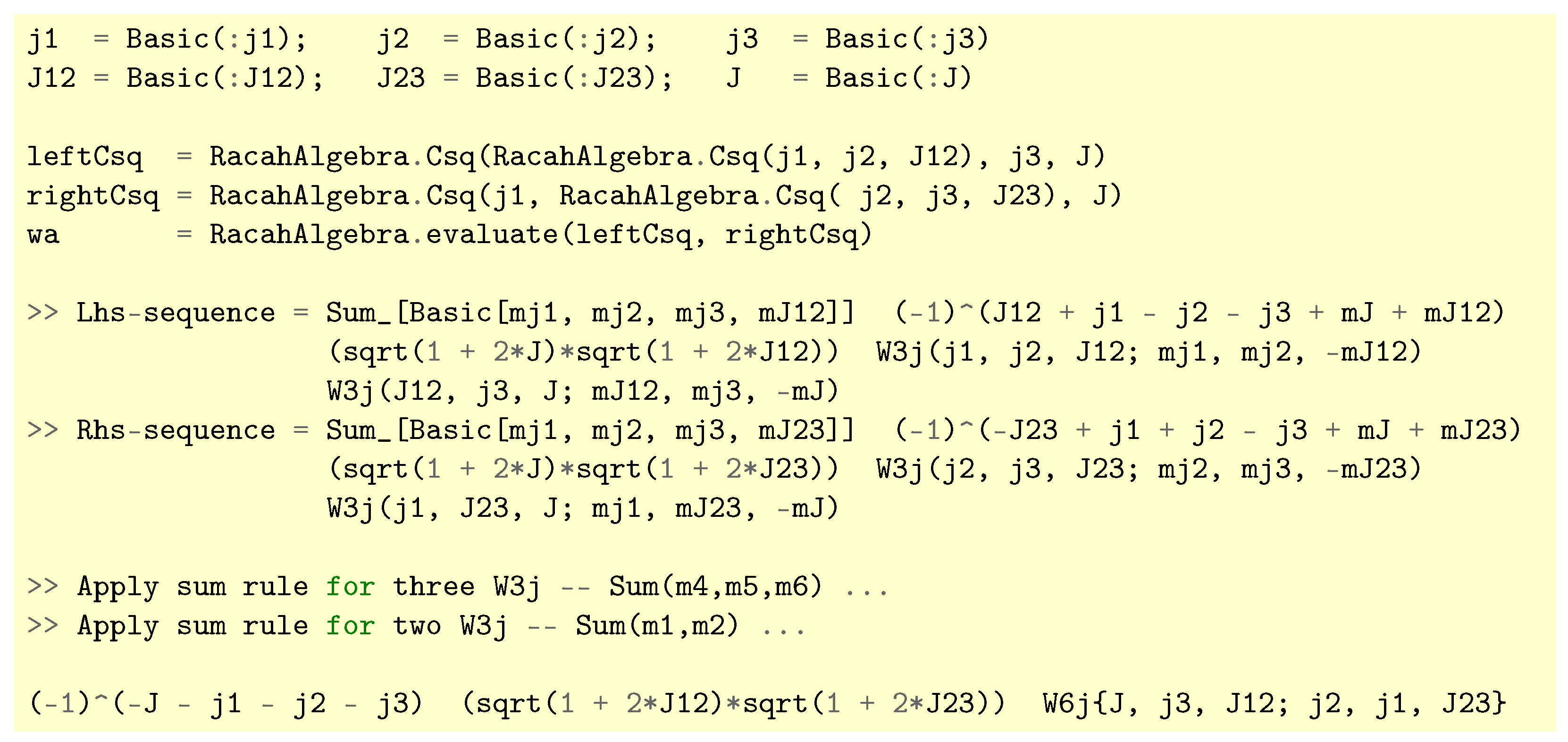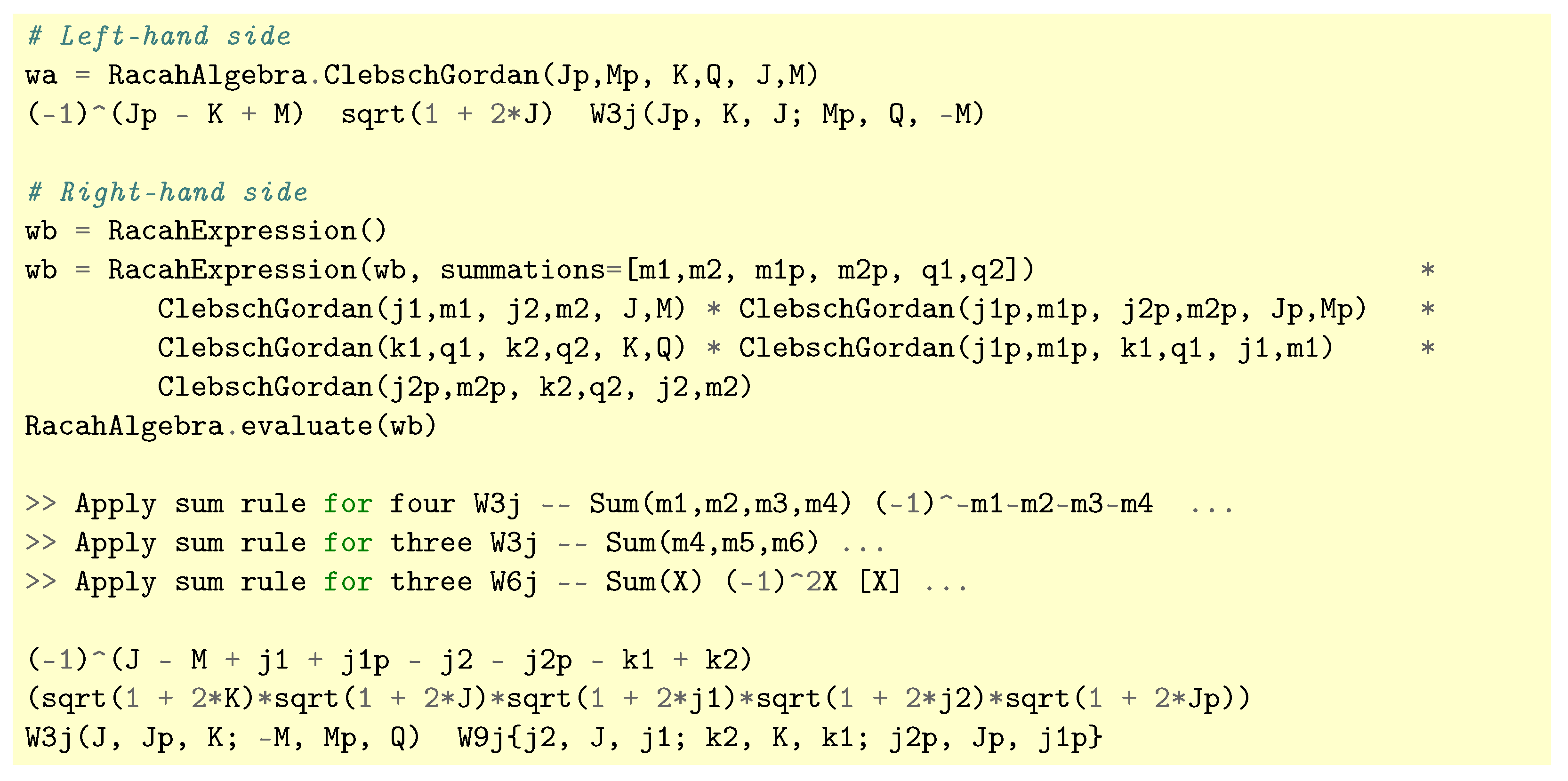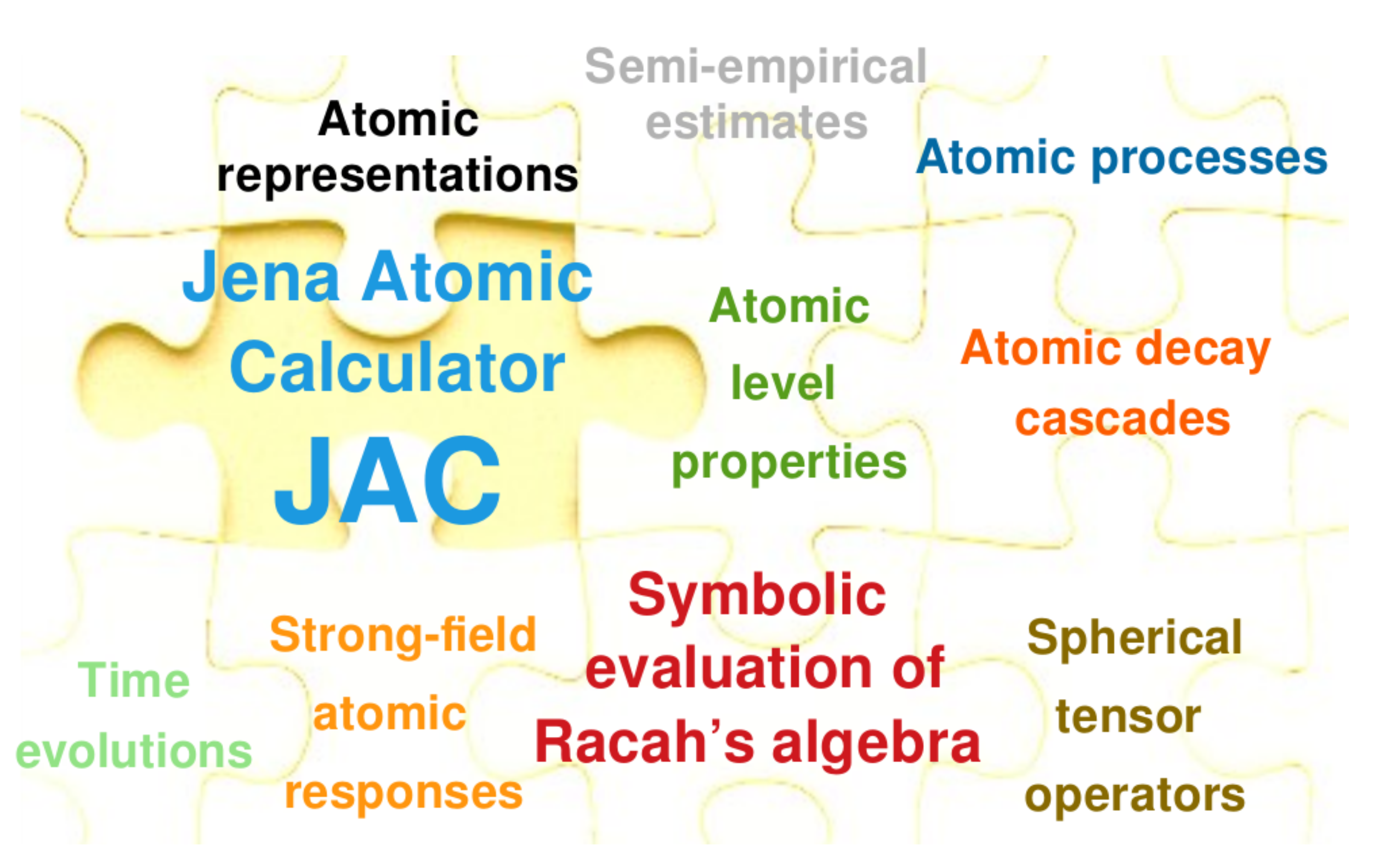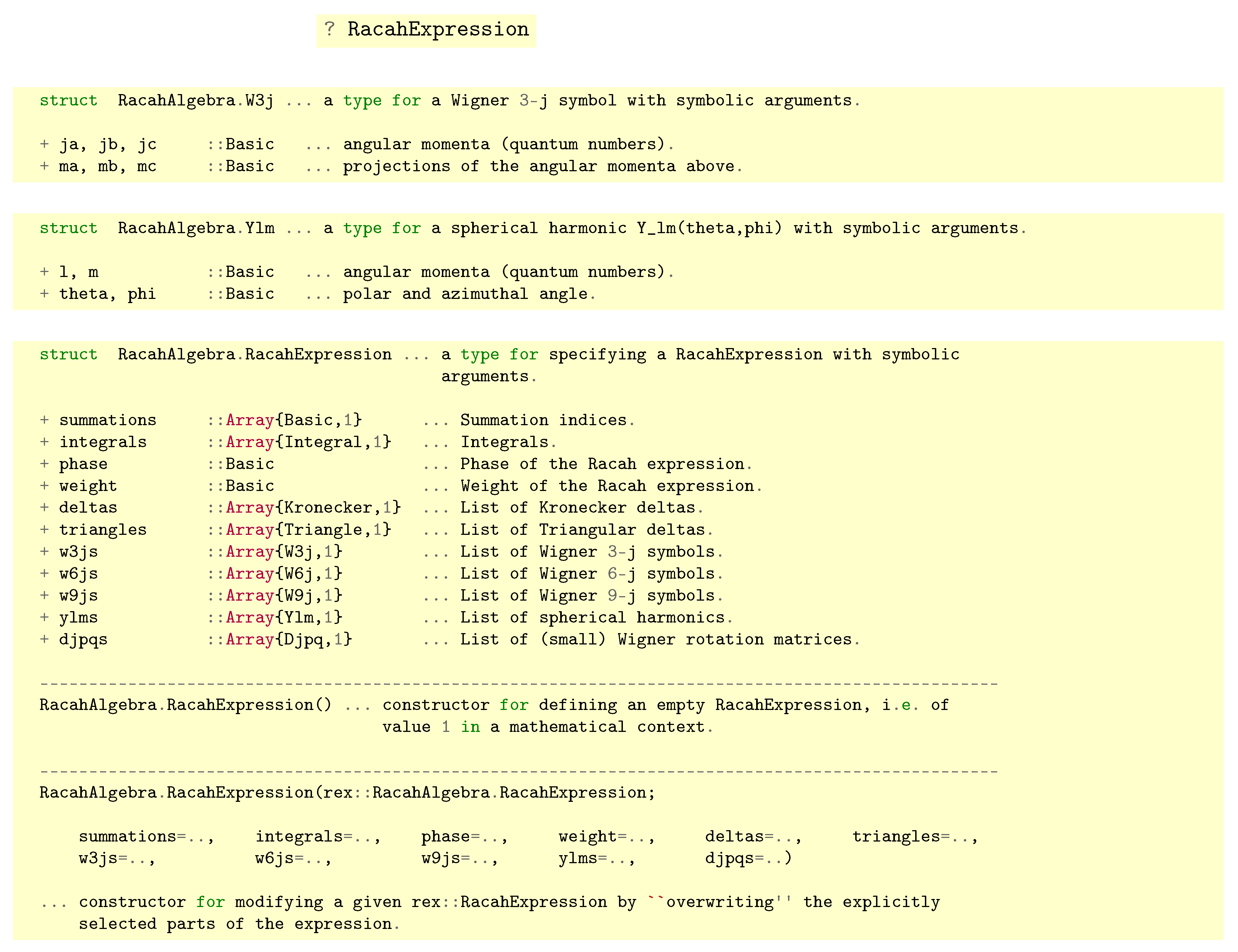Symbolic Evaluation of Expressions from Racah’s Algebra
Abstract
:1. Racah’s Algebra in Atomic and Many-Body Physics
2. Making Use of Racah’s Algebra
2.1. Advantages of Using Racah’s Algebra
2.2. Typical Expressions and Difficulties from Racah’s Algebra
2.3. Techniques for Simplifying Racah Algebra Expressions
- (i)
- Use of so-called special values of the Wigner n-j symbols, if some of the arguments fulfill certain fixed relations. For this strategy, each Wigner n-j symbol can be analyzed separately and, if the special value applies, replaced by a simple algebraic expression, and without that the summation indices or other parts of the Racah expression has to be considered.
- (ii)
- Use of orthogonality and sum rules for the Wigner n-j symbols. This requires a very careful analysis of the Racah expression as a whole, since all summation variables not only need to be in the correct position in the (arguments of the) Wigner n-j symbols, but they must also contribute to a correct phase and weight of the overall expression. Moreover, the same variables may not occur in other Wigner symbols of the Racah expression, which are not part of the selected rule.
- (iii)
- Use of orthogonality and sum rules for the spherical harmonics and Wigner rotation matrices. Apart from requests similar to strategy (ii), the proper angular dependence of the functions involved has to be ensured for a valid simplification of the Racah expression.
- (iv)
- Use of integration rules; these rules can be formally treated quite similar to the former sum rules, if we assume that all sums and integrals can be interchanged in such expressions. For (iii) and (iv), only a small subset of the known sum and integration rules have so far been implemented in Jac.
3. Tools and Implementation
3.1. Brief Overview about Jac
3.2. Data Structures for Symbolic Evaluations
3.3. Sum Rule Evaluation
3.4. Integration Rules for the Spherical Harmonics and Rotation Matrices
4. Derivation and Evaluation of Racah Expressions
4.1. Recoupling of Angular Momenta

4.2. Matrix Elements of Tensor Operators within a Coupled Basis
 and easily find, after some reordering of notations, the well-known relation
and easily find, after some reordering of notations, the well-known relation
4.3. Angular Reduction in Feynman–Goldstone Diagrams
5. Conclusions
Funding
Institutional Review Board Statement
Informed Consent Statement
Conflicts of Interest
References
- Racah, G. Theory of complex spectra I. Phys. Rev. 1941, 61, 186. [Google Scholar] [CrossRef]
- Racah, G. Theory of complex spectra II. Phys. Rev. 1942, 62, 438. [Google Scholar] [CrossRef]
- Racah, G. Theory of complex spectra III. Phys. Rev. 1943, 63, 367. [Google Scholar] [CrossRef]
- Balashov, V.V.; Grum-Grzhimailo, A.N.; Kabachnik, N.M. Polarization and Correlation Phenomena in Atomic Collisions: A Practical Theory Course; Kluwer Academics/Plenum Press: New York, NY, USA, 2000. [Google Scholar]
- Wigner, E.P. Group Theory and its Application to the Quantum Mechanics of Atomic Spectra; Academic Press: New York, NY, USA, 1959. [Google Scholar]
- El–Baz, E.; Castel, B. Graphical Methods of Spin Algebras in Atomic, Nuclear and Particle Physics; Marcel Dekker: New York, NY, USA, 1972. [Google Scholar]
- Biedenharn, L.C.; Louck, J.D. The Racah-Wigner Algebra in Quantum Theory; Cambridge University Press: Cambridge, UK, 1981. [Google Scholar]
- Adams, B.G. Algebraic Approach to Simple Quantum Systems; Springer: Berlin/Heidelberg Germany, 1994. [Google Scholar]
- Fritzsche, S.; Varga, S.; Geschke, D.; Fricke, B. Maple procedures for the coupling of angular momenta. II. Sum rule evaluation. Comput. Phys. Commun. 1998, 111, 167. [Google Scholar] [CrossRef]
- Pope, C.N.; Shen, X.; Romans, L.J. W∞ and the Racah-Wigner algebra. Nucl. Phys. B 1990, 339, 191. [Google Scholar] [CrossRef]
- Shimizu, Y.; Yoshida, H.; Okada, K.; Muramatsu, Y.; Saito, N. Ultra-high resolution angle-resolved measurement of Auger emission from the photoexcited 1s−1→3p state of Ne. J. Phys. 2000, B33, L685. [Google Scholar]
- Kabachnik, N.M.; Fritzsche, S.; Grum-Grzhimailo, A.N.; Meyer, M.; Ueda, K. Coherence and correlations in photoinduced Auger and fluorescence cascades in atoms. Phys. Rep. 2007, 451, 155. [Google Scholar] [CrossRef]
- Gaigalas, G.; Fritzsche, S.; Rudzikas, Z. Reduced coefficients of fractional parentage and matrix elements of the tensor W(kqkj) in jj-coupling. At. Data Nucl. Data Tables 2000, 76, 235. [Google Scholar] [CrossRef]
- Zare, R.N. Angular Momentum: Understanding Spatial Aspects in Chemistry and Physics; John Whiley & Sons: New York, NY, USA, 1988. [Google Scholar]
- Müller, N.; Khalil, T.; Pohl, M.; Uphues, T.; Polcik, M.; Rader, O.; Heigl, F.; Starke, K.; Fritzsche, S.; Kabachnik, N.M.; et al. Interference of spin states in resonant photoemission induced by circularly polarized light from magnetized Gd. Phys. Rev. 2006, B74, 161401(R). [Google Scholar] [CrossRef]
- Sitenko, A.; Tartakovskii, V. Theory of Nucleus: Nuclear Structure and Nuclear Interaction; Springer Science+Business Media, B.V.: Dordrecht, UK, 1997. [Google Scholar]
- Grant, I.P. Relativistic Quantum Theory of Atoms and Molecules: Theory and Computation; Springer: New York, NY, USA, 2007. [Google Scholar]
- Varshalovich, D.A.; Moskalev, A.N.; Khersonskii, V.K. Quantum Theory of Angular Momentum; World Scientific: Singapore, 1988. [Google Scholar]
- Gaigalas, G.; Fritzsche, S.; Grant, I.P. Calculation of angular coefficients in jj-coupling. Comput. Phys. Commun. 2001, 139, 263. [Google Scholar] [CrossRef] [Green Version]
- Fritzsche, S.; Froese Fischer, C.; Gaigalas, G. A program for relativistic configuration interaction calculations. Comput. Phys. Commun. 2002, 148, 103. [Google Scholar] [CrossRef]
- Fritzsche, S. Application of point–group symmetries in chemistry and physics: A computer-algebraic approach. Int. J. Quant. Chem. 2006, 106, 98. [Google Scholar] [CrossRef]
- Soguel, R.N.; Volotka, A.V.; Tryapitsyna, E.V.; Glazov, D.A.; Kosheleva, V.P.; Fritzsche, S. Redefined vacuum approach and gauge-invariant subsets in two-photon-exchange diagrams for closed-shells system with a valence electron. Phys. Rev. 2020, A103, 042818. [Google Scholar]
- Raychev, P. Quantum Groups: Application to Nuclear and Molecular Spectroscopy. Adv. Quant. Chem. 1995, 26, 239. [Google Scholar]
- Fritzsche, S.; Grum-Grzhimailo, A.N.; Gryzlova, E.V.; Kabachnik, N.M. Sequential two-photon double ionization of Kr atoms. J. Phys. 2009, B42, 145602. [Google Scholar] [CrossRef]
- Regge, T. Symmetry properties of Clebsch-Gordan coefficients. Nuovo C. 1958, 10, 544. [Google Scholar] [CrossRef]
- Lindgren, I.; Morrison, J. Atomic Many—Body Theory, 2nd ed.; Springer: Berlin/Heidelberg, Germany, 1986. [Google Scholar]
- Fritzsche, S. A fresh computational approach to atomic structures, processes and cascades. Comp. Phys. Commun. 2019, 240, 1. [Google Scholar] [CrossRef]
- Fritzsche, S. Jac: User Guide, Compendium & Theoretical Background. Available online: https://github.com/OpenJAC/JAC.jl (accessed on 1 June 2021).
- Fritzsche, S. Large-scale accurate structure calculations for open-shell atoms and ions. Phys. Scr. 2002, T100, 37. [Google Scholar] [CrossRef]
- Cheal, B.; Cocolios, T.E.; Fritzsche, S. Laser spectroscopy of radioactive isotopes: Role and limitations of accurate isotope-shift calculations. Phys. Rev. 2012, A86, 042501. [Google Scholar] [CrossRef]
- Fritzsche, S.; Surzhykov, A. Approximate atomic Green functions. Molecules 2021, 26, 2660. [Google Scholar] [CrossRef]
- Fritzsche, S.; Palmeri, P.; Schippers, S. Atomic cascade computations. Symmetry 2021, 13, 520. [Google Scholar] [CrossRef]
- Beerwerth, R.; Buhr, T.; Perry-Sassmannshausen, A.; Stock, S.O.; Bari, S.; Holste, K.; Kilcoyne, A.L.D.; Reinwardt, S.; Ricz, S.; Savin, D.W. Near L-edge single and multiple photoionization of triply charged iron ions. Astrophys. J. 2019, 887, 189. [Google Scholar] [CrossRef] [Green Version]
- Schippers, S.; Beerwerth, R.; Bari, S.; Buhr, T.; Holste, K.; Kilcoyne, A.L.D.; Perry-Sassmannshausen, A.; Phaneuf, R.A.; Reinwardt, S.; Savin, D.W. Near L-edge single and multiple photoionization of doubly charged iron ions. Astrophys. J. 2021, 908, 52. [Google Scholar] [CrossRef]
- SymEngine.jl. Available online: https://github.com/symengine/SymEngine.jl (accessed on 1 June 2021).
- Fritzsche, S. Maple procedures for the coupling of angular momenta. I. Data structures and numerical evaluation. Comp. Phys. Commun. 1997, 103, 51. [Google Scholar] [CrossRef]
- Fritzsche, S.; Inghoff, T.; Bastug, T.; Tomaselli, M. Maple procedures for the coupling of angular momenta. V. Recoupling coefficients. Comput. Phys. Commun. 2001, 139, 314. [Google Scholar] [CrossRef]
- Pagaran, J.; Fritzsche, S.; Gaigalas, G. Maple procedures for the coupling of angular momenta. IX.Wigner D-functions and rotation matrices. Comput. Phys. Commun. 2006, 174, 616. [Google Scholar] [CrossRef]
- Julia Comes with a Full-Featured Interactive and Command-Line REPL (Read-Eval-Print Loop) That Is Built into the Executable of the Language. Available online: https://docs.julialang.org/en/v1/stdlib/REPL/ (accessed on 1 June 2021).
- Louck, J.D. New recursion relation for the Clebsch-Gordan coefficients. Phys. Rev. 1958, 110, 815. [Google Scholar] [CrossRef]
- Rotenberg, M.; Bivins, R.; Metrapolis, N.; Wooten, J.K., Jr. The 3-j and 6-j Symbols; The Technology Press Cambridge: Cambridge, MA, USA, 1959. [Google Scholar]
- Judd, B.R. Operator Techniques in Atomic Spectroscopy; McGraw-Hill: New York, NY, USA, 1963. [Google Scholar]
- Gaigalas, G. Zalandauskas, T.; Fritzsche, S. Spectroscopic LSJ notation for atomic levels as obtained from relativistic calculations. Comput. Phys. Commun. 2004, 157, 239. [Google Scholar] [CrossRef] [Green Version]
- Rose, M.E. Elementary Theory of Angular Momentum; Dover Publications Inc.: New York, NY, USA, 1995. [Google Scholar]
- Fritzsche, S.; Mani, B.K.; Angom, D. A computer—Algebraic approach to the derivation of Feynman- Goldstone perturbation expansions for open-shell atoms and molecules. Adv. Quant. Chem. 2008, 53, 177. [Google Scholar]
- Fritzsche, S. The Ratip program for relativistic calculations of atomic transition, ionization and recombination properties. Comp. Phys. Commun. 2012, 183, 1525. [Google Scholar] [CrossRef]
- Soguel, R.N.; Volotka, A.V.; Glazov, D.A.; Fritzsche, S. Many-electron QED with redefined vacuum approach. Symmetry 2021, 13, 1014. [Google Scholar] [CrossRef]


| struct & brief explanation. |
|---|
| AbstractRecursionW3j: defines an abstract type for the recursion rules of Wigner 3-j symbols; this type comprises the concrete (singleton) types: RecursionW3jMagnetic to select a recursion with regard to the magnetic quantum numbers; RecursionW3jOneStep for a step-1 recursion of the j-quantum numbers; RecursionW3jHalfStep for a step- recursion of the j-quantum numbers; and RecursionW3jLouck for a recursion due to Louck [40]. |
| ClebschGordan: re-writes a Clebsch-Gordan coefficient in terms of a Wigner 3-j symbol and, thus, a Racah expression. |
| ClebschGordanExpansion: re-writes a (standard) Clebsch-Gordan expansion |
| in terms of a Wigner 3-j symbol and, thus, a Racah expression but without the basis vectors. |
| Csq: a type for a coupling sequence of three angular momenta with symbolic arguments that can be employed recursively. |
| Delta: a type for a Kronecker delta with symbolic arguments. |
| Dfunction: re-writes a Wigner rotation matrix into a small rotation matrix and, thus, a Racah expression. |
| Djpq: a type for a (small) Wigner rotation matrix with symbolic arguments. |
| Integral: a type for an integral , typically over some angle, with symbolic arguments and given lower and upper bound. |
| RacahExpression: a type for a Racah expression (1) with symbolic arguments; cf. Figure 1. |
| Triangle: a type for a triangular delta with symbolic arguments. |
| W3j: a type for a Wigner symbol with symbolic arguments; cf. Figure 1. |
| W6j: a type for a Wigner symbol with symbolic arguments. |
| W9j: a type for a Wigner symbol with symbolic arguments. |
| Ylm: a type for a spherical harmonic with symbolic arguments; cf. Figure 1. |
| Function & brief explanation. |
|---|
| evaluate(): attempts to evaluate or simplify a Wigner n-j symbol, recoupling coefficient or a Racah expression as a whole by means of special values, if the keyword special = true is given, or by sum rules. |
| equivalentForm(): generates an (randomly chosen) equivalent form for a Wigner n-j symbol or a Racah expression by using either the classical symmetries or those due to Regge [25]. |
| purifyPhase(): purifies the overall phase of a Racah expression so that the contribution of any angular momentum occurs as . An equivalent phase is returned. |
| selectW3j(): selects one of various pre-defined Wigner 3-j symbols for which usually special values are known; this function has been implemented mainly for test purposes and is similarly available also for the other Wigner symbols. |
| simplifyDeltas(): simplifies, if possible, all Kronecker deltas in a Racah expression if a corresponding summation is to carried out. |
| simplifyTriangles(): simplifies all triangular deltas in a Racah expression. |
| specialValue(): attempts to find a special value for a given Wigner n-j symbol. |
| symmetricForms(): generates a list of all equivalent symmetric forms of a Wigner n-j symbol, spherical harmonic or Wigner rotation matrix . |
Publisher’s Note: MDPI stays neutral with regard to jurisdictional claims in published maps and institutional affiliations. |
© 2021 by the author. Licensee MDPI, Basel, Switzerland. This article is an open access article distributed under the terms and conditions of the Creative Commons Attribution (CC BY) license (https://creativecommons.org/licenses/by/4.0/).
Share and Cite
Fritzsche, S. Symbolic Evaluation of Expressions from Racah’s Algebra. Symmetry 2021, 13, 1558. https://doi.org/10.3390/sym13091558
Fritzsche S. Symbolic Evaluation of Expressions from Racah’s Algebra. Symmetry. 2021; 13(9):1558. https://doi.org/10.3390/sym13091558
Chicago/Turabian StyleFritzsche, Stephan. 2021. "Symbolic Evaluation of Expressions from Racah’s Algebra" Symmetry 13, no. 9: 1558. https://doi.org/10.3390/sym13091558
APA StyleFritzsche, S. (2021). Symbolic Evaluation of Expressions from Racah’s Algebra. Symmetry, 13(9), 1558. https://doi.org/10.3390/sym13091558






